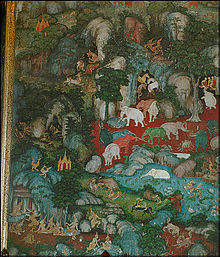Kinnari

Kinnari ( Sanskrit किंनरी kiṁnarī ; also Kinari , Kinaree , Kinnaree , Ginnarie or Ginnaree ; Burmese : kin-na-yi ) is a mythological being who lives on the slopes of the Himaphan forest ( snow forest ).
The kinnari is depicted in Thai , Cambodian , Lao, and Burmese mythology as a being who is half-woman and half-bird. She has the head, torso, and arms of a woman, but the wings, tail, and feet of a swan. She is known for her dance, her songs and her poetry and is the traditional symbol of female beauty, grace and perfection. The male counterpart to Kinnari is called Kinnara ( किंनर kiṁnara ) or Kinnorn .
Mythological origin
In Indian mythology, Kinnaris and Kinnaras are hybrids of humans and birds or horses and belong to the lower deities who live at the foot of the holy mountain Meru . They are often portrayed as heavenly musicians. That is why an ancient Indian stringed instrument was called the Kinnari Vina . In a text from Gujarat from the middle of the 12th century, a second name is Saranga Vina . Kinnaris were depicted on medieval Indian stone temples either as small celestial beings observing the actual events from above, or they were integrated very small as decorative motifs in medallions in the base area.
Thailand
Kinnari ( Thai : กินรี ) were already mentioned in Thai literature in the Traiphum Phra Ruang from the 14th century. They live with many other mythical creatures in the Himaphan forest , which is located on the slopes of Mount Meru , the central axis of the Buddhist worldview. In Thai art there are innumerable depictions of the Kinnari, always portrayed as young women wearing angelic costumes. The lower part of their body is that of a Hong (Thai: หงส์ ), a mythical swan, which means they are supposed to be able to fly back and forth between the human world and the fable worlds.
Famous representations of the Kinnari
- The most famous Kinnari in Thailand is a character named Manorah (Thai: มโนราห์ ) from the Panyasa Jataka (Thai: ปัญญา ส ชาดก ). Part of this piece is a dance called Manorah-Buchayan, which is one of the most esoteric among the high classical dances in Thailand.
- On the "Upper Terrace" of Wat Phra Kaeo in Bangkok there are gold-plated, life-size statues of 14 mythical creatures from the Himaphan Forest, one of which represents a chinorn. It is not to be confused with the statue of a Theppaksi, which, in contrast to the Kinnorn, has human legs.
- On the soles of the feet of the great reclining Buddha of Wat Phra Chetuphon in Bangkok, the 108 Buddhist symbols are depicted as mother-of-pearl inlay, two of these symbols are a kinnari and a kinnorn.
- Thai Airways International publishes a monthly magazine called Kinnaree.
Myanmar
Burmese Buddhists believe that Buddha lived as a kinnara four times in his 136 previous lives as an animal. Here, too, Kinnari is one of the 108 auspicious symbols in the Buddha's footprint .
